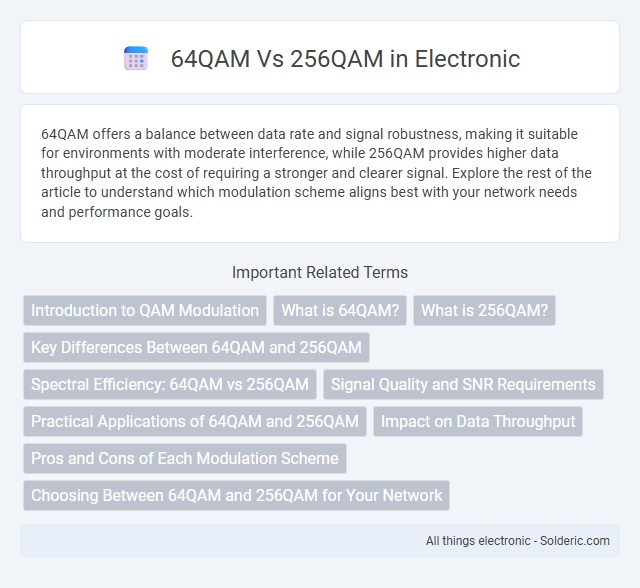64QAM offers a balance between data rate and signal robustness, making it suitable for environments with moderate interference, while 256QAM provides higher data throughput at the cost of requiring a stronger and clearer signal. Explore the rest of the article to understand which modulation scheme aligns best with your network needs and performance goals.
Comparison Table
| Feature | 64QAM | 256QAM |
|---|---|---|
| Modulation Type | Quadrature Amplitude Modulation | Quadrature Amplitude Modulation |
| Bits per Symbol | 6 bits | 8 bits |
| Data Rate | Lower than 256QAM | Higher than 64QAM |
| Spectral Efficiency | Moderate | High |
| Signal-to-Noise Ratio (SNR) Requirement | Lower SNR needed (~20-25 dB) | Higher SNR needed (~30-35 dB) |
| Error Rate | Lower bit error rate under noisy conditions | Higher bit error rate if SNR is insufficient |
| Use Case | Robust communication in moderate environments | High throughput in clean signals |
Introduction to QAM Modulation
Quadrature Amplitude Modulation (QAM) combines amplitude and phase variations to represent data, with 64QAM using 64 distinct symbols and 256QAM using 256 symbols to increase data rates. Higher-order QAM like 256QAM improves spectral efficiency but requires a stronger signal-to-noise ratio (SNR) for accurate demodulation compared to 64QAM. Your choice between 64QAM and 256QAM impacts communication system performance, balancing speed and reliability.
What is 64QAM?
64QAM (64 Quadrature Amplitude Modulation) is a digital modulation scheme that transmits data by varying the amplitude of two carrier waves, representing six bits per symbol through 64 distinct signal combinations. It balances data rate and robustness, offering moderate spectral efficiency and resilience to noise, commonly used in wireless communication standards like LTE and Wi-Fi. Compared to higher-order schemes such as 256QAM, 64QAM provides lower data throughput but better performance in environments with lower signal quality.
What is 256QAM?
256QAM (Quadrature Amplitude Modulation) is a sophisticated digital modulation scheme that transmits data by varying both the amplitude and phase of a carrier signal, encoding 256 distinct symbols per cycle. Compared to 64QAM, which encodes 64 symbols, 256QAM increases data capacity by allowing 8 bits per symbol, enhancing throughput and spectral efficiency. Your network performance can benefit from 256QAM by supporting higher data rates, though it requires a stronger signal-to-noise ratio for reliable communication.
Key Differences Between 64QAM and 256QAM
64QAM and 256QAM differ primarily in modulation order, where 64QAM uses 64 symbols and 256QAM uses 256 symbols, enabling higher data rates with 256QAM due to increased bits per symbol. The trade-off lies in sensitivity to noise and signal quality, as 256QAM requires a stronger signal-to-noise ratio (SNR) for reliable transmission compared to 64QAM. Consequently, 64QAM offers better robustness and is suitable for lower quality channels while 256QAM provides enhanced spectral efficiency for high-quality signal conditions.
Spectral Efficiency: 64QAM vs 256QAM
256QAM offers higher spectral efficiency compared to 64QAM by encoding 8 bits per symbol, whereas 64QAM encodes only 6 bits per symbol, effectively increasing data throughput within the same bandwidth. However, 256QAM requires a higher signal-to-noise ratio (SNR) for reliable transmission, making it more susceptible to errors in noisy environments. Your choice between 64QAM and 256QAM depends on balancing the need for data rate and channel conditions to optimize overall network performance.
Signal Quality and SNR Requirements
256QAM requires a higher Signal-to-Noise Ratio (SNR) than 64QAM to maintain reliable signal quality, making it more sensitive to noise and interference. While 256QAM offers increased data throughput by encoding more bits per symbol, it demands better channel conditions to avoid errors. Your choice between 64QAM and 256QAM should consider the available SNR to ensure optimal signal integrity and performance.
Practical Applications of 64QAM and 256QAM
64QAM is commonly used in wireless communication systems such as Wi-Fi and LTE due to its balance between data throughput and signal robustness, making it ideal for environments with moderate interference. 256QAM is favored in advanced broadband technologies like 5G and DOCSIS 3.1, where higher spectral efficiency and faster data rates are critical, albeit requiring higher signal quality and lower noise levels. Practical deployment of 256QAM often occurs in controlled settings such as fiber-optic networks and urban cellular infrastructure to maximize throughput performance.
Impact on Data Throughput
256QAM provides significantly higher data throughput compared to 64QAM by encoding 8 bits per symbol versus 6 bits per symbol, resulting in a theoretical 33% increase in spectral efficiency. This increased modulation order enables faster data rates within the same bandwidth, making 256QAM ideal for high-capacity wireless and cable networks. However, the improved throughput of 256QAM requires a higher signal-to-noise ratio (SNR) to maintain reliable transmission, limiting its effective range compared to 64QAM.
Pros and Cons of Each Modulation Scheme
64QAM offers a balanced trade-off between spectral efficiency and signal robustness, providing reliable performance in moderate noise environments with lower complexity and power consumption. 256QAM increases data throughput by encoding more bits per symbol, maximizing bandwidth utilization but requiring higher signal-to-noise ratios and advanced error correction to maintain link quality. The choice between 64QAM and 256QAM depends on channel conditions, system design goals, and the need for either stability or higher transmission capacity.
Choosing Between 64QAM and 256QAM for Your Network
Choosing between 64QAM and 256QAM depends on your network's requirements for data throughput and signal quality; 256QAM offers higher spectral efficiency with up to 8 bits per symbol compared to 6 bits per symbol in 64QAM, enabling faster data rates. However, 256QAM demands a stronger signal-to-noise ratio (SNR) to maintain error-free communication, making it less reliable in environments with high interference or longer distances. Evaluating your network's channel conditions, user density, and performance goals is essential to determine whether the increased capacity of 256QAM justifies its higher sensitivity compared to the more robust 64QAM modulation scheme.
64QAM vs 256QAM Infographic

 solderic.com
solderic.com